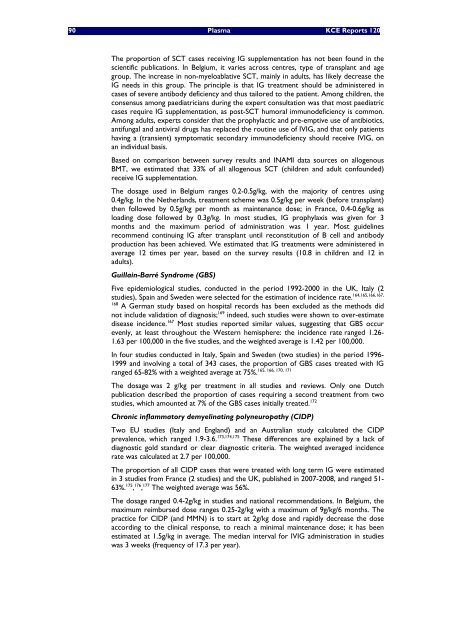The report is available in English with a French summary - KCE
The report is available in English with a French summary - KCE
The report is available in English with a French summary - KCE
Create successful ePaper yourself
Turn your PDF publications into a flip-book with our unique Google optimized e-Paper software.
90 Plasma <strong>KCE</strong> Reports 120<br />
<strong>The</strong> proportion of SCT cases receiv<strong>in</strong>g IG supplementation has not been found <strong>in</strong> the<br />
scientific publications. In Belgium, it varies across centres, type of transplant and age<br />
group. <strong>The</strong> <strong>in</strong>crease <strong>in</strong> non-myeloablative SCT, ma<strong>in</strong>ly <strong>in</strong> adults, has likely decrease the<br />
IG needs <strong>in</strong> th<strong>is</strong> group. <strong>The</strong> pr<strong>in</strong>ciple <strong>is</strong> that IG treatment should be adm<strong>in</strong><strong>is</strong>tered <strong>in</strong><br />
cases of severe antibody deficiency and thus tailored to the patient. Among children, the<br />
consensus among paediatricians dur<strong>in</strong>g the expert consultation was that most paediatric<br />
cases require IG supplementation, as post-SCT humoral immunodeficiency <strong>is</strong> common.<br />
Among adults, experts consider that the prophylactic and pre-emptive use of antibiotics,<br />
antifungal and antiviral drugs has replaced the rout<strong>in</strong>e use of IVIG, and that only patients<br />
hav<strong>in</strong>g a (transient) symptomatic secondary immunodeficiency should receive IVIG, on<br />
an <strong>in</strong>dividual bas<strong>is</strong>.<br />
Based on compar<strong>is</strong>on between survey results and INAMI data sources on allogenous<br />
BMT, we estimated that 33% of all allogenous SCT (children and adult confounded)<br />
receive IG supplementation.<br />
<strong>The</strong> dosage used <strong>in</strong> Belgium ranges 0.2-0.5g/kg, <strong>with</strong> the majority of centres us<strong>in</strong>g<br />
0.4g/kg. In the Netherlands, treatment scheme was 0.5g/kg per week (before transplant)<br />
then followed by 0.5g/kg per month as ma<strong>in</strong>tenance dose; <strong>in</strong> France, 0.4-0.6g/kg as<br />
load<strong>in</strong>g dose followed by 0.3g/kg. In most studies, IG prophylax<strong>is</strong> was given for 3<br />
months and the maximum period of adm<strong>in</strong><strong>is</strong>tration was 1 year. Most guidel<strong>in</strong>es<br />
recommend cont<strong>in</strong>u<strong>in</strong>g IG after transplant until reconstitution of B cell and antibody<br />
production has been achieved. We estimated that IG treatments were adm<strong>in</strong><strong>is</strong>tered <strong>in</strong><br />
average 12 times per year, based on the survey results (10.8 <strong>in</strong> children and 12 <strong>in</strong><br />
adults).<br />
Guilla<strong>in</strong>-Barré Syndrome (GBS)<br />
Five epidemiological studies, conducted <strong>in</strong> the period 1992-2000 <strong>in</strong> the UK, Italy (2<br />
studies), Spa<strong>in</strong> and Sweden were selected for the estimation of <strong>in</strong>cidence rate. 164,165,166,167,<br />
168<br />
A German study based on hospital records has been excluded as the methods did<br />
not <strong>in</strong>clude validation of diagnos<strong>is</strong>; 169 <strong>in</strong>deed, such studies were shown to over-estimate<br />
d<strong>is</strong>ease <strong>in</strong>cidence. 167 Most studies <strong>report</strong>ed similar values, suggest<strong>in</strong>g that GBS occur<br />
evenly, at least throughout the Western hem<strong>is</strong>phere: the <strong>in</strong>cidence rate ranged 1.26-<br />
1.63 per 100,000 <strong>in</strong> the five studies, and the weighted average <strong>is</strong> 1.42 per 100,000.<br />
In four studies conducted <strong>in</strong> Italy, Spa<strong>in</strong> and Sweden (two studies) <strong>in</strong> the period 1996-<br />
1999 and <strong>in</strong>volv<strong>in</strong>g a total of 343 cases, the proportion of GBS cases treated <strong>with</strong> IG<br />
165, 166, 170, 171<br />
ranged 65-82% <strong>with</strong> a weighted average at 75%.<br />
<strong>The</strong> dosage was 2 g/kg per treatment <strong>in</strong> all studies and reviews. Only one Dutch<br />
publication described the proportion of cases requir<strong>in</strong>g a second treatment from two<br />
studies, which amounted at 7% of the GBS cases <strong>in</strong>itially treated. 172<br />
Chronic <strong>in</strong>flammatory demyel<strong>in</strong>at<strong>in</strong>g polyneuropathy (CIDP)<br />
Two EU studies (Italy and England) and an Australian study calculated the CIDP<br />
prevalence, which ranged 1.9-3.6. 173,174,175 <strong>The</strong>se differences are expla<strong>in</strong>ed by a lack of<br />
diagnostic gold standard or clear diagnostic criteria. <strong>The</strong> weighted averaged <strong>in</strong>cidence<br />
rate was calculated at 2.7 per 100,000.<br />
<strong>The</strong> proportion of all CIDP cases that were treated <strong>with</strong> long term IG were estimated<br />
<strong>in</strong> 3 studies from France (2 studies) and the UK, publ<strong>is</strong>hed <strong>in</strong> 2007-2008, and ranged 51-<br />
63%. 175 , 176 , 177 <strong>The</strong> weighted average was 56%.<br />
<strong>The</strong> dosage ranged 0.4-2g/kg <strong>in</strong> studies and national recommendations. In Belgium, the<br />
maximum reimbursed dose ranges 0.25-2g/kg <strong>with</strong> a maximum of 9g/kg/6 months. <strong>The</strong><br />
practice for CIDP (and MMN) <strong>is</strong> to start at 2g/kg dose and rapidly decrease the dose<br />
accord<strong>in</strong>g to the cl<strong>in</strong>ical response, to reach a m<strong>in</strong>imal ma<strong>in</strong>tenance dose; it has been<br />
estimated at 1.5g/kg <strong>in</strong> average. <strong>The</strong> median <strong>in</strong>terval for IVIG adm<strong>in</strong><strong>is</strong>tration <strong>in</strong> studies<br />
was 3 weeks (frequency of 17.3 per year).

















